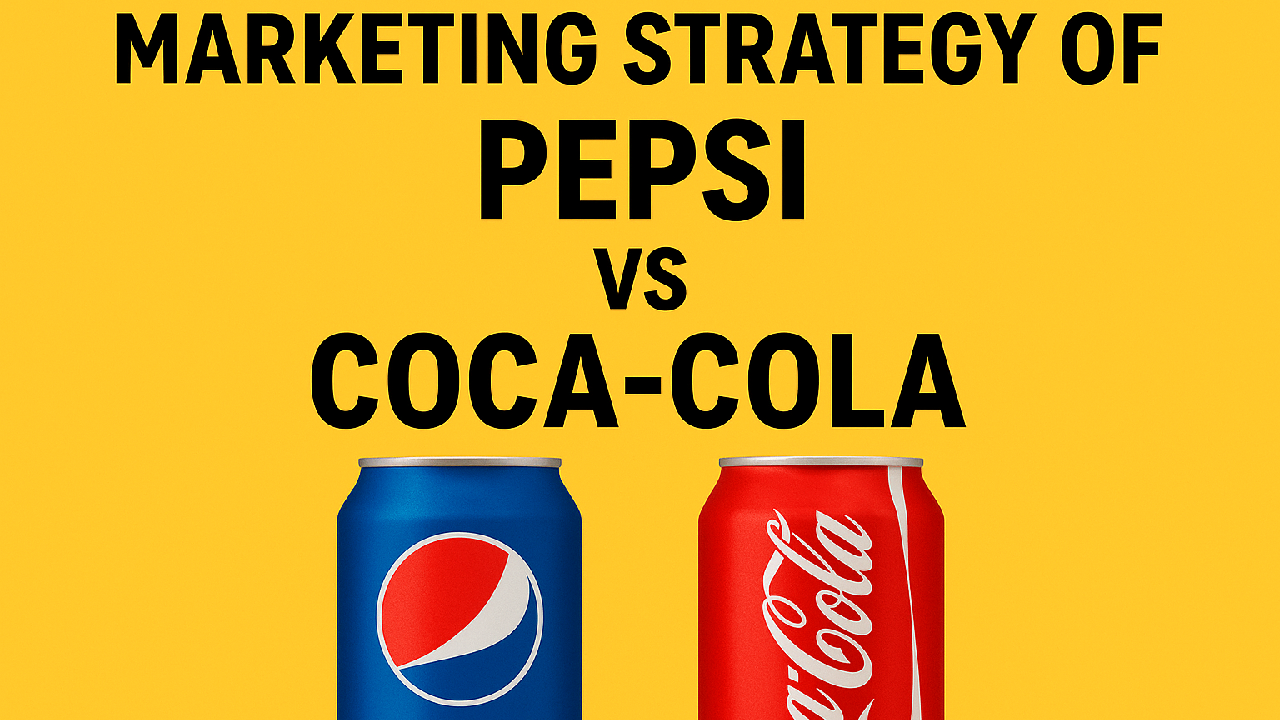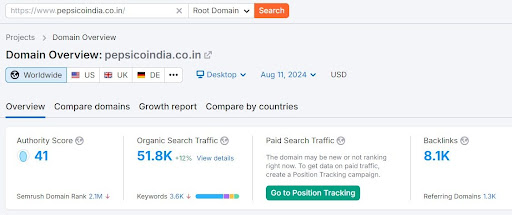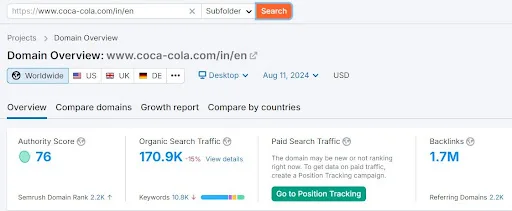
When it comes to cola,Two names that come to your mind when you think about cola are ‘Pepsi’ and ‘Coca Cola’. Both brands have built their loyal fanbase and loyalty. But attracting this fanbase requires communicating with them relevantly. Both these brands stand out when it comes to interacting with their consumers, whether it is through meme marketing or celebrity endorsements they both have a unique approach and tone of voice. And the reason for that is their excellent marketing strategies.
The rivalry between Pepsi and Coca-Cola, often referred to as the “cola wars,” has been a significant part of the brand’s identity, influencing its marketing strategies for decades. We as a digital marketing agency know the importance of reaching out to consumers correctly and conveniently and that is the reason we have de-coded the marketing strategies of both these brands to help you understand it better.
Table of contents
- Brand DNA
- Target Audience Analysis
- Marketing Strategies of the Pepsi
- Marketing Strategies of Coca-Cola
- In Conclusion
- Frequently Asked Questions
Brand DNA
Pepsi
Pepsi began its journey in 1893 when Caleb Bradham created a drink called “Brad’s Drink” to help with indigestion, selling it in his drugstore. By 1898, it was renamed Pepsi-Cola and soon after, it became a strong rival to Coca-Cola. By the 1930s, Pepsi had secured its place as the second most popular soft drink globally. Pepsi’s popularity only grew over the years, leading to the formation of the PepsiCo conglomerate in 1965.
Operating in over 200 countries, PepsiCo reported more than $91 billion in revenue in 2023. Pepsi, one of the brand’s flagship products, holds the position as the second most valuable soft drink brand globally, just behind Coca-Cola. Pepsi’s marketing strategy has always been bold, focusing on youth culture, innovation and engaging advertising campaigns.
Coca Cola
Coke has long been associated with happiness and in Mandarin, “Coca-Cola” even translates to “Delicious Happiness.” This concept is central to the brand’s marketing, which aims to spread joy with every campaign. From its modest start in 1886 in Atlanta, Georgia, when John Pemberton sold just nine servings a day. Coca-Cola has grown into a global giant, embodying the essence of happiness in every bottle.
The company’s portfolio includes well-known sparkling drinks like Coca-Cola, Diet Coke, Fanta and Sprite, as well as hydration options such as Dasani, smartwater and Powerade. The brand’s focus on innovation, sustainability and global reach continues to make it a dominant force in the market, driving its marketing strategy and consumer engagement.
Pepsi’s youthful, bold marketing contrasts with Coca-Cola’s focus on heritage and universal appeal, setting the stage for their ongoing rivalry.
Target Audience Analysis
Pepsi
Pepsi’s target audience is diverse, primarily focusing on teens, young adults and early middle-aged consumers in the US and around the world. The brand has a strong appeal to millennials and Gen Z, who resonate with its vibrant and energetic marketing campaigns. Over the years, Pepsi has successfully tapped into music, sports and pop culture, showcasing its youthful spirit through memorable marketing campaigns like the Michael Jackson ad and “The Joy of Pepsi” ad campaign. By partnering with trendsetters and influential figures, Pepsi remains connected to its audience’s desire for excitement and adventure, solidifying its position as a top choice among younger consumers.
Coca Cola
Coca-Cola primarily targets 10- to 25-year-old consumers who want their colas to taste intensely. This age is believed to be the core of Coca-Cola’s target market as the consumers in this age group require refreshing drinks that are associated with their busy lives. However, the brand does extend to a secondary market of 25- to 40-year-olds as it has been identified that various age groups have diversified tastes and consumption habits. Coca-Cola has a marketing strategy whereby it tries to reach out to everybody while focusing on these demographics. For example, one major audience is young people whose ages are between 10 and 35 years and the category really dictates innovative campaigns and new product lines for the company. By so doing, it keeps the product relevant to all generations.
Marketing Strategies of the Pepsi
Social Media Marketing Strategy
Pepsi’s social media game is bold, youthful, and interactive. With over 1.9M Instagram followers (global), the brand uses a mix of:
- Trending hashtags & cultural moments – e.g., Father’s Day twist on “Yeh Dil Maange More” → “Yeh Dads Maange More,” adding humour and relatability.
- Interactive campaigns that invite audience participation.
- UGC (User Generated Content) to make consumers part of the conversation.
If you want to create relatable, high-engagement content like Pepsi, a specialised social media marketing agency can help you craft it.
Celebrity Endorsements
Pepsi’s celebrity endorsement strategy has been central to its marketing success. From the “Pepsi Challenge” in 1984 to the Pepsi Generation ads, the brand has used big names like Michael Jackson, Britney Spears and Beyoncé to create campaigns that resonate with pop culture.
Pepsi doesn’t just partner with celebrities; they integrate them into larger events like the Super Bowl halftime show, making their presence felt across multiple platforms.
Another stand-out endorsement of Pepsi in India is the collaboration with Bollywood actor Ranveer Singh. He prompted the “Rise up Baby” campaign which gained over 100M views and turned out to be a huge success.
As a branding agency, we see how Pepsi’s blend of celebrity endorsements and pop culture keeps them relevant and engaging in the competitive soft drink market.
Influencer Marketing
Pepsi is increasingly focusing on influencer marketing to engage with its audience in a more relatable way. By partnering with influencers who resonate with their target demographic, Pepsi is able to create content that feels authentic and connects on a personal level. For instance, their collaboration with singing and fashion influencer Avanti Nagral for Friendship Day resulted in a popular rap song about friendship, helping the brand reach a younger, trend-savvy audience.
If you want to stand out with influencer marketing like Pepsi, then reach out to a content creation agency that can help you with creating
SEO Optimisation
Pepsi’s SEO marketing strategy is remarkably effective. SEMrush shows that Pepsi has 170.9k of website traffic organically, providing them with a strong edge in search visibility. By strategically targeting a wide variety of keywords, Pepsi consistently secures top placements in search engine results.

Linking to specific URLs associated with these target keywords is a common SEO tactic. Pepsi is currently backlinking on 1.7M websites. It helps search engines understand the content of Pepsi’s pages and deliver relevant results to users. If you also want to rank on top organically like Pepsi, then reaching out to an SEO company is the best option!
Marketing Strategies of Coca Cola
Social Media Marketing Strategy
We see how Coca-Cola uses these strategies to keep its content fresh and connect with a wide audience, reinforcing its position as a social media superstar.
Coca-Cola’s content is trend-driven and inclusive:
- Jumps on cultural wins – e.g., Neeraj Chopra’s Paris Olympics silver.
- Never misses special days – from Emoji Day to Friendship Day.
- Inshort, they use short-form videos and witty captions to spark shares.
Unlike Pepsi, Coca-Cola’s social media tone blends heritage and modern pop trends for wider age appeal.
Meme Marketing Strategy
Coca-Cola’s social media marketing strategy includes a strong focus on meme marketing, effectively engaging with millennial and Gen Z audiences. Their collaboration with Swiggy featured a humorous post that playfully contrasted perceptions of what people think they do versus what they actually do.
This clever approach not only entertains but also resonates with younger consumers, helping to strengthen brand loyalty. As a Meme marketing agency, we recognise how Coca-Cola’s use of relatable content and humour keeps its messaging fresh and relevant, making it a standout in the competitive landscape.
Iconic Television Advertisements
Coca-Cola has a strong legacy of iconic television advertisements that effectively communicate its brand message of joy and togetherness. Campaigns like “Share a Coke” invite consumers to connect through personalised bottles, creating a sense of community.
Their “#BestCokeEver?” campaign, featuring Bollywood actress Kriti Sanon, poses an intriguing question that encourages people to try Coca-Cola Zero Sugar for themselves, sparking curiosity and engagement.
Another memorable campaign, ‘Khud Ko Jagaa, Ek Thanda Lagaa,’ features actors Janhvi Kapoor and Ishaan Khatter, urging viewers to take a break from their busy lives and enjoy an ice-cold Coke.
This emphasis on enjoying life’s little moments reinforces Coca-Cola’s image as a beverage that brings people together.
SEO Optimisation
Coca-Cola’s SEO marketing strategy is highly effective. According to SEMrush, Coca-Cola has 51.8k of organic website traffic, giving it a strong advantage in search visibility. By strategically targeting a diverse range of keywords, Coca-Cola consistently achieves high placements in search engine results, that too without doing any paid search traffic. Their focus on brand-related keywords, promotional campaigns, and product names significantly enhances their SEO. Keywords such as “Coca-Cola near me” and “Coca-Cola products” are particularly valuable in driving local search traffic and increasing brand engagement.

In Conclusion
Pepsi and Coca-Cola have both implemented impressive marketing strategies that highlight their rivalry in the ‘Cola Wars.’ Pepsi’s youthful vibe resonates with millennials and Gen Z through relatable campaigns like “Yeh Dil Maange More” and impactful celebrity endorsements, while their focus on influencer marketing boosts engagement and loyalty.
In contrast, Coca-Cola reinforces its global leadership with social media efforts that tap into current trends and meme marketing that connects with younger audiences. Their iconic television ads further enhance brand recognition and community engagement. This ongoing competition showcases both brands’ commitment to dominating the beverage market. If you want to improve your marketing strategies, reach out to us at hello@florafountain.com.
Frequently Asked Questions
When it comes to cola,Two names that come to your mind when you think about cola are ‘Pepsi’ and ‘Coca Cola’. Both brands have built their loyal fanbase and loyalty. But attracting this fanbase requires communicating with them relevantly. Both these brands stand out when it comes to interacting with their consumers, whether it is through meme marketing or celebrity endorsements they both have a unique approach and tone of voice. And the reason for that is their excellent marketing strategies.
The rivalry between Pepsi and Coca-Cola, often referred to as the “cola wars,” has been a significant part of the brand’s identity, influencing its marketing strategies for decades. We as a digital marketing agency know the importance of reaching out to consumers correctly and conveniently and that is the reason we have de-coded the marketing strategies of both these brands to help you understand it better.
Table of contents
- Brand DNA
- Target Audience Analysis
- Marketing Strategies of the Pepsi
- Marketing Strategies of Coca-Cola
- In Conclusion
- Frequently Asked Questions
Brand DNA
Pepsi
Pepsi began its journey in 1893 when Caleb Bradham created a drink called “Brad’s Drink” to help with indigestion, selling it in his drugstore. By 1898, it was renamed Pepsi-Cola and soon after, it became a strong rival to Coca-Cola. By the 1930s, Pepsi had secured its place as the second most popular soft drink globally. Pepsi’s popularity only grew over the years, leading to the formation of the PepsiCo conglomerate in 1965.
Operating in over 200 countries, PepsiCo reported more than $91 billion in revenue in 2023. Pepsi, one of the brand’s flagship products, holds the position as the second most valuable soft drink brand globally, just behind Coca-Cola. Pepsi’s marketing strategy has always been bold, focusing on youth culture, innovation and engaging advertising campaigns.
Coca Cola
Coke has long been associated with happiness and in Mandarin, “Coca-Cola” even translates to “Delicious Happiness.” This concept is central to the brand’s marketing, which aims to spread joy with every campaign. From its modest start in 1886 in Atlanta, Georgia, when John Pemberton sold just nine servings a day. Coca-Cola has grown into a global giant, embodying the essence of happiness in every bottle.
The company’s portfolio includes well-known sparkling drinks like Coca-Cola, Diet Coke, Fanta and Sprite, as well as hydration options such as Dasani, smartwater and Powerade. The brand’s focus on innovation, sustainability and global reach continues to make it a dominant force in the market, driving its marketing strategy and consumer engagement.
Pepsi’s youthful, bold marketing contrasts with Coca-Cola’s focus on heritage and universal appeal, setting the stage for their ongoing rivalry.
Target Audience Analysis
Pepsi
Pepsi’s target audience is diverse, primarily focusing on teens, young adults and early middle-aged consumers in the US and around the world. The brand has a strong appeal to millennials and Gen Z, who resonate with its vibrant and energetic marketing campaigns. Over the years, Pepsi has successfully tapped into music, sports and pop culture, showcasing its youthful spirit through memorable marketing campaigns like the Michael Jackson ad and “The Joy of Pepsi” ad campaign. By partnering with trendsetters and influential figures, Pepsi remains connected to its audience’s desire for excitement and adventure, solidifying its position as a top choice among younger consumers.
Coca Cola
Coca-Cola primarily targets 10- to 25-year-old consumers who want their colas to taste intensely. This age is believed to be the core of Coca-Cola’s target market as the consumers in this age group require refreshing drinks that are associated with their busy lives. However, the brand does extend to a secondary market of 25- to 40-year-olds as it has been identified that various age groups have diversified tastes and consumption habits. Coca-Cola has a marketing strategy whereby it tries to reach out to everybody while focusing on these demographics. For example, one major audience is young people whose ages are between 10 and 35 years and the category really dictates innovative campaigns and new product lines for the company. By so doing, it keeps the product relevant to all generations.
Marketing Strategies of the Pepsi
Social Media Marketing Strategy
Pepsi’s social media game is bold, youthful, and interactive. With over 1.9M Instagram followers (global), the brand uses a mix of:
- Trending hashtags & cultural moments – e.g., Father’s Day twist on “Yeh Dil Maange More” → “Yeh Dads Maange More,” adding humour and relatability.
- Interactive campaigns that invite audience participation.
- UGC (User Generated Content) to make consumers part of the conversation.
If you want to create relatable, high-engagement content like Pepsi, a specialised social media marketing agency can help you craft it.
Celebrity Endorsements
Pepsi’s celebrity endorsement strategy has been central to its marketing success. From the “Pepsi Challenge” in 1984 to the Pepsi Generation ads, the brand has used big names like Michael Jackson, Britney Spears and Beyoncé to create campaigns that resonate with pop culture.
Pepsi doesn’t just partner with celebrities; they integrate them into larger events like the Super Bowl halftime show, making their presence felt across multiple platforms.
Another stand-out endorsement of Pepsi in India is the collaboration with Bollywood actor Ranveer Singh. He prompted the “Rise up Baby” campaign which gained over 100M views and turned out to be a huge success.
As a branding agency, we see how Pepsi’s blend of celebrity endorsements and pop culture keeps them relevant and engaging in the competitive soft drink market.
Influencer Marketing
Pepsi is increasingly focusing on influencer marketing to engage with its audience in a more relatable way. By partnering with influencers who resonate with their target demographic, Pepsi is able to create content that feels authentic and connects on a personal level. For instance, their collaboration with singing and fashion influencer Avanti Nagral for Friendship Day resulted in a popular rap song about friendship, helping the brand reach a younger, trend-savvy audience.
If you want to stand out with influencer marketing like Pepsi, then reach out to a content creation agency that can help you with creating
SEO Optimisation
Pepsi’s SEO marketing strategy is remarkably effective. SEMrush shows that Pepsi has 170.9k of website traffic organically, providing them with a strong edge in search visibility. By strategically targeting a wide variety of keywords, Pepsi consistently secures top placements in search engine results.

Linking to specific URLs associated with these target keywords is a common SEO tactic. Pepsi is currently backlinking on 1.7M websites. It helps search engines understand the content of Pepsi’s pages and deliver relevant results to users. If you also want to rank on top organically like Pepsi, then reaching out to an SEO company is the best option!
Marketing Strategies of Coca Cola
Social Media Marketing Strategy
We see how Coca-Cola uses these strategies to keep its content fresh and connect with a wide audience, reinforcing its position as a social media superstar.
Coca-Cola’s content is trend-driven and inclusive:
- Jumps on cultural wins – e.g., Neeraj Chopra’s Paris Olympics silver.
- Never misses special days – from Emoji Day to Friendship Day.
- Inshort, they use short-form videos and witty captions to spark shares.
Unlike Pepsi, Coca-Cola’s social media tone blends heritage and modern pop trends for wider age appeal.
Meme Marketing Strategy
Coca-Cola’s social media marketing strategy includes a strong focus on meme marketing, effectively engaging with millennial and Gen Z audiences. Their collaboration with Swiggy featured a humorous post that playfully contrasted perceptions of what people think they do versus what they actually do.
This clever approach not only entertains but also resonates with younger consumers, helping to strengthen brand loyalty. As a Meme marketing agency, we recognise how Coca-Cola’s use of relatable content and humour keeps its messaging fresh and relevant, making it a standout in the competitive landscape.
Iconic Television Advertisements
Coca-Cola has a strong legacy of iconic television advertisements that effectively communicate its brand message of joy and togetherness. Campaigns like “Share a Coke” invite consumers to connect through personalised bottles, creating a sense of community.
Their “#BestCokeEver?” campaign, featuring Bollywood actress Kriti Sanon, poses an intriguing question that encourages people to try Coca-Cola Zero Sugar for themselves, sparking curiosity and engagement.
Another memorable campaign, ‘Khud Ko Jagaa, Ek Thanda Lagaa,’ features actors Janhvi Kapoor and Ishaan Khatter, urging viewers to take a break from their busy lives and enjoy an ice-cold Coke.
This emphasis on enjoying life’s little moments reinforces Coca-Cola’s image as a beverage that brings people together.
SEO Optimisation
Coca-Cola’s SEO marketing strategy is highly effective. According to SEMrush, Coca-Cola has 51.8k of organic website traffic, giving it a strong advantage in search visibility. By strategically targeting a diverse range of keywords, Coca-Cola consistently achieves high placements in search engine results, that too without doing any paid search traffic. Their focus on brand-related keywords, promotional campaigns, and product names significantly enhances their SEO. Keywords such as “Coca-Cola near me” and “Coca-Cola products” are particularly valuable in driving local search traffic and increasing brand engagement.

In Conclusion
Pepsi and Coca-Cola have both implemented impressive marketing strategies that highlight their rivalry in the ‘Cola Wars.’ Pepsi’s youthful vibe resonates with millennials and Gen Z through relatable campaigns like “Yeh Dil Maange More” and impactful celebrity endorsements, while their focus on influencer marketing boosts engagement and loyalty.
In contrast, Coca-Cola reinforces its global leadership with social media efforts that tap into current trends and meme marketing that connects with younger audiences. Their iconic television ads further enhance brand recognition and community engagement. This ongoing competition showcases both brands’ commitment to dominating the beverage market. If you want to improve your marketing strategies, reach out to us at hello@florafountain.com.



